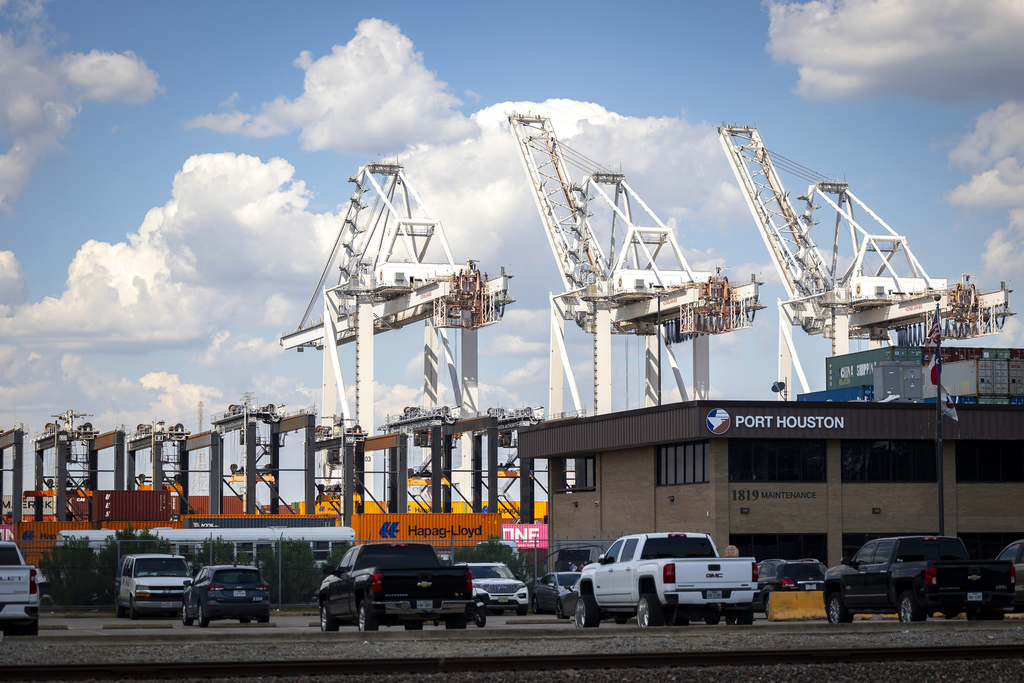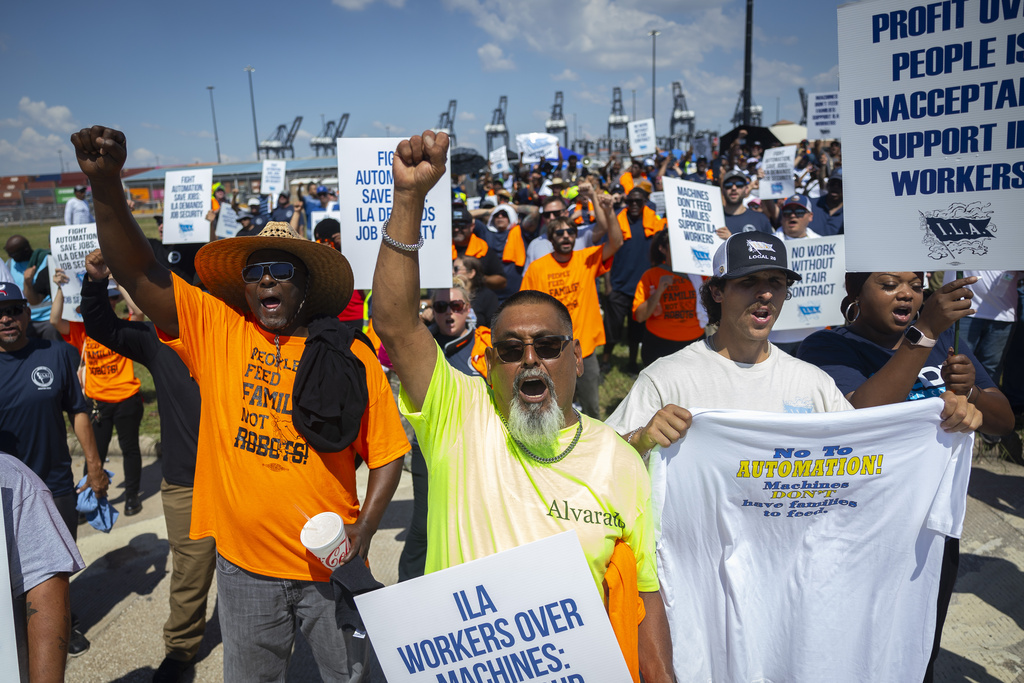Dockworkers Strike Suspended: U.S. Ports Resume Operations \ Newslooks \ Washington DC \ Mary Sidiqi \ Evening Edition \ U.S. dockworkers from Maine to Texas went on strike this week, shutting down major ports. However, an agreement was reached to suspend the strike until January 15, allowing negotiations to continue. The dockworkers’ union is pushing for higher wages and restrictions on automation, impacting vital ports that manage half of the nation’s cargo.

Dockworkers Strike Quick Looks
- Strike Suspension: Dockworkers strike paused until January 15 as both sides negotiate a new contract.
- Union Demands: Higher wages and a complete ban on automation at U.S. ports were the main issues.
- Affected Ports: Major ports like Baltimore, New York, New Jersey, and Houston were impacted by the strike.
- Government Stance: President Biden chose not to intervene, citing his belief in collective bargaining over the Taft-Hartley Act.
- State Actions: Florida Governor Ron DeSantis deployed the National Guard to help maintain order, while other state governors monitored for price gouging.
- Consumer Impact: Consumers likely won’t see immediate price hikes due to the suspension, though prolonged disruption could have caused shortages.
Deep Look
This week, U.S. ports from Maine to Texas came to a standstill as the International Longshoremen’s Association (ILA), representing approximately 45,000 dockworkers, initiated their first major strike since 1977. Workers began walking picket lines on Tuesday, halting operations along the East and Gulf coasts. The strike threatened significant disruptions to the supply chain, particularly with the holiday shopping season approaching and a tight presidential election on the horizon.
However, by Thursday, the ILA and the United States Maritime Alliance, which represents the ports, reached a deal to temporarily suspend the strike until January 15. This agreement provides a window of opportunity to negotiate a new contract while ensuring that union members resume work immediately.
What Led to the Strike?
The dockworkers’ union demanded a substantial pay raise and sought to prevent automation of cranes, gates, and container-moving trucks at 36 major U.S. ports, which handle around half of the nation’s cargo from ships. Their initial demand was for a 77% pay raise over six years, intended to compensate for inflation and years of minimal wage growth. Current dockworker salaries range from a base of $81,000 to upwards of $200,000 annually for those taking on large amounts of overtime.
In response, the United States Maritime Alliance had offered a 50% pay raise over the same period, promising to retain automation limits from the previous contract. They also proposed increasing employer contributions to retirement plans and enhancing healthcare benefits. Despite these offers, the union went ahead with the strike, forcing a temporary shutdown at critical points in the supply chain.
Ports Affected by the Shutdown
The strike caused disruption at major ports with diverse specializations. Baltimore and Brunswick, Georgia, which are the busiest auto ports in the nation, were affected, along with Philadelphia, a key hub for importing fruits and vegetables. New Orleans, which handles coffee imports from South America and Southeast Asia and chemicals from North Europe, was also shut down.
Other important ports impacted included Boston; New York/New Jersey; Norfolk, Virginia; Wilmington, North Carolina; Charleston, South Carolina; Savannah, Georgia; Tampa, Florida; Mobile, Alabama; and Houston. While most ports can handle any goods, certain ports are particularly vital to specific industries, making the strike’s effects potentially far-reaching.
Could the Government Have Stepped In?
Under the 1947 Taft-Hartley Act, President Joe Biden had the power to request a court order that would initiate an 80-day cooling-off period, effectively pausing the strike if it were deemed a threat to the U.S. economy. However, Biden indicated that he had no intention of intervening. During a press exchange on Sunday, Biden stated, “Because it’s collective bargaining, I don’t believe in Taft-Hartley,” emphasizing his preference to respect the negotiation process between the union and the ports.
State Responses to the Strike
In response to the strike, Florida Governor Ron DeSantis ordered the deployment of the Florida National Guard and the Florida State Guard to the state’s ports, with the goal of maintaining order and possibly assisting in resuming port operations. DeSantis expressed concern about the impact on hurricane recovery efforts, especially with Hurricane Helene’s aftermath still affecting Florida communities. “This has the potential of really disrupting the hurricane recovery and of hurting the people who were victims of the storm,” he said.
Other states also took action. Governors from Maryland, Massachusetts, New Jersey, and New York issued a joint statement indicating that they were closely monitoring the situation for potential price gouging, as the strike could have led to increased costs for essential goods.
Consumer Impact and Economic Consequences
With the strike now suspended, consumers are unlikely to see immediate effects in the form of significant price hikes or shortages. However, a prolonged stoppage could have created considerable disruptions, particularly in the availability of goods like fruits, vegetables, and automobiles. Given that most holiday retail goods have already arrived, the immediate impact on holiday shopping would have been minimal, but prices for perishable items could have risen had the strike continued.
The situation also came at a politically sensitive time, with Election Day just around the corner. Extended supply chain disruptions could have had unfavorable economic effects, reminiscent of the pandemic-related price surges that affected many goods.
Highly Perishable Goods at Risk
One of the most pressing concerns during the strike was the status of perishable goods. Container loads of bananas and other highly perishable items were stuck at some ports. Agriculture Secretary Tom Vilsack highlighted that keeping the strike short was key to avoiding widespread shortages and increased prices, particularly for fresh produce.
Business Contingency Plans
Businesses had already started making contingency plans in light of the strike. Since the major supply chain disruptions of 2021, many retailers have adapted by securing orders earlier and stockpiling goods to protect against potential strikes and logistical hiccups. Rick Haase, owner of the Patina gift shop chain in Minnesota, said his approach involved securing inventory well ahead of time and storing goods to avoid stock issues. However, Haase noted that storing goods for longer can result in increased retail prices as businesses seek to recover storage costs.
Similarly, Jay Foreman, CEO of Basic Fun, a toy company based in Boca Raton, Florida, shifted all container shipments to West Coast ports, particularly Los Angeles and Long Beach, to avoid potential East Coast delays. This maneuver, while necessary, added 10% to 20% in additional costs that his company would have to absorb since their prices were already locked in for upcoming months. Foreman acknowledged the possibility of raising prices in late 2025 if labor disputes continue to disrupt operations.
Daniel Vasquez, owner of Dynamic Auto Movers in Miami, also made preparations by increasing inventory levels, especially for vehicles that are slow to ship. He began diversifying his port and shipping partnerships, expanding relationships with smaller ports and shipping companies to reduce the risk of relying on congested areas.







